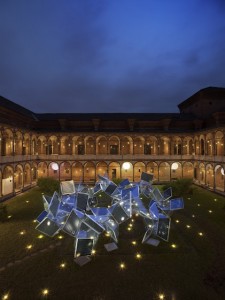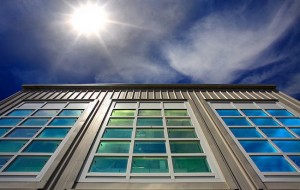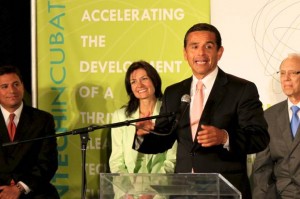 Developers of solar technology are turning to nature to better understand how plants use the sunlight to store and use energy. The concept of solar trees is showing up all over the world. In Italy. Panasonic will showcase its total solutions for creating, storing, saving and managing energy at the Milano Salone del Mobile 2012 exhibition, which will be held in Milan this April. At this year’s exhibition, Panasonic will present an energy cycle, comparing it to an ecological cycle that begins with photosynthesis, starting with energy creation (through solar panels), and continuing to energy storage (through storage batteries) and energy saving (through LED and organic LED lights), with each stage of the cycle being controlled by an energy management system. The installation, which is the first outdoor exhibit for Panasonic, was designed by noted young architect Akihisa Hirata, whose organic vision of a living, breathing architecture reflects the open yet interdependent symbiotic cycles in nature.
Developers of solar technology are turning to nature to better understand how plants use the sunlight to store and use energy. The concept of solar trees is showing up all over the world. In Italy. Panasonic will showcase its total solutions for creating, storing, saving and managing energy at the Milano Salone del Mobile 2012 exhibition, which will be held in Milan this April. At this year’s exhibition, Panasonic will present an energy cycle, comparing it to an ecological cycle that begins with photosynthesis, starting with energy creation (through solar panels), and continuing to energy storage (through storage batteries) and energy saving (through LED and organic LED lights), with each stage of the cycle being controlled by an energy management system. The installation, which is the first outdoor exhibit for Panasonic, was designed by noted young architect Akihisa Hirata, whose organic vision of a living, breathing architecture reflects the open yet interdependent symbiotic cycles in nature.
“Based on the dynamic of photosynthesis, I envisioned the leaves, fruit and flowers of a tree linking the entire corridor space in a cyclical network of creating, storing and saving energy. A new image of human endeavor open to the limitless energy of the sun, to the energy channels we have built and to the cycles of the biosphere. I wanted to shape a new interpretation of nature at this historic juncture,” said Akihisa Hirata.
 In response to the common goal of “shifting to sustainability,” Panasonic is working to make our lives more pleasant and reduce our impact on the environment. The 2012 installation “Photosynthesis” exemplifies this dual ecology approach in a controlled-cycle energy management “tree” with solar panel “leaves”, energy-storing battery “fruit” and energy-saving LED/OLED “flowers”. It’s a new experience and a new world of possibilities for these greening times.This installation takes place at INTERNI LEGACY, University of Milan.
In response to the common goal of “shifting to sustainability,” Panasonic is working to make our lives more pleasant and reduce our impact on the environment. The 2012 installation “Photosynthesis” exemplifies this dual ecology approach in a controlled-cycle energy management “tree” with solar panel “leaves”, energy-storing battery “fruit” and energy-saving LED/OLED “flowers”. It’s a new experience and a new world of possibilities for these greening times.This installation takes place at INTERNI LEGACY, University of Milan.









